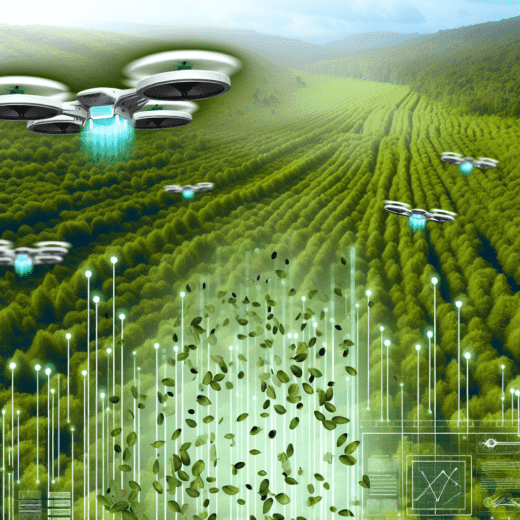Introduction
In the wake of global climate change and environmental degradation, reforestation has emerged as a critical component in mitigating environmental crises. With traditional methods often proving inadequate in the face of rapidly advancing deforestation, innovations like tree planting drones are poised to disrupt the landscape of reforestation efforts. These high-tech drones can plant seeds in hard-to-reach areas, significantly accelerating the pace of reforestation. This technological advancement offers immense potential for innovation and market disruption, presenting unique challenges and incredible opportunities, especially in the startup ecosystem. This blog post aims to explore the multifaceted journey of developing and scaling a startup in the tree planting drones sector.
Innovation Potential of Tree Planting Drones
The development of tree planting drones signifies a remarkable leap in reforestation technology. These drones are equipped with specialized seed pods that can be deployed from the air, efficiently planting in terrains that are otherwise inaccessible. The innovation lies not just in the drones’ engineering but also in their ability to integrate data analysis and environmental science to optimize seed distribution. Technologically, these drones can be programmed with algorithms that analyze soil quality, weather conditions, and land topography, ensuring that each seed has the highest chance of survival.
A prime example of this innovation is BioCarbon Engineering, a startup that has developed drones capable of planting thousands of trees per day. These drones not only plant seeds but also monitor the health and growth of the trees over time, using advanced imaging technologies. By automating planting processes and providing continuous monitoring, tree planting drones offer a scalable solution to one of the most pressing environmental issues.
Market Disruption
Tree planting drones are set to disrupt traditional reforestation methods, which often involve manual labor, significant time investments, and logistical challenges. The deployment of drones significantly reduces the cost and time required to plant trees, making reforestation efforts more economical and feasible on a large scale. This disruption could lead to a shift in how governments, NGOs, and private organizations approach environmental projects.
Furthermore, the drones’ ability to reach inaccessible areas opens up new possibilities for increasing biodiversity in regions that have been difficult to reforest. For instance, steep terrains or post-wildfire landscapes can be efficiently targeted, ensuring a more comprehensive approach to ecosystem restoration.
Key Challenges
Despite their potential, tree planting drone startups face significant challenges. One of the major hurdles is technological reliability; ensuring drones can efficiently operate in diverse environmental conditions is crucial. Drones must be able to withstand varying weather conditions and function in complex terrains without compromising the planting process.
Regulatory challenges also present a significant barrier. The use of drones for commercial and environmental purposes is often subject to stringent regulations that vary between countries. Navigating these legal landscapes is essential for startups aiming to operate on a global scale.
Another challenge lies in the scalability of operations. While drones can significantly increase planting speed, managing widespread operations and maintaining the quality of reforestation efforts across different regions requires robust logistical and managerial frameworks.
Unique Opportunities
The unique opportunities for startups in the tree planting drone sector are vast. The increasing global focus on sustainability and carbon offsetting presents a substantial market for drone-enabled reforestation services. Companies can tap into rising corporate responsibility initiatives and governmental reforestation programs seeking efficient and innovative solutions to environmental challenges.
Moreover, the data analytics capabilities of tree planting drones offer additional value-added services. Startups can provide insights into climate resilience, biodiversity impacts, and carbon sequestration potentials, thus amplifying their service offerings beyond mere reforestation.
Partnerships with NGOs and environmental agencies can further enhance market reach and credibility. By collaborating with organizations that have established networks and expertise in ecological conservation, startups can better align their technology with ground realities and increase their impact potential.
Strategies for Fundraising
Securing funding is essential for startups working to develop tree planting drones. Given the capital-intensive nature of drone technology and the need for continuous innovation, strategic fundraising is crucial.
One strategy is to focus on impact investment funds. As environmental consciousness grows, there is a rising pool of investors interested in supporting sustainability-focused ventures. By highlighting the positive environmental and social impacts of their technology, startups can attract impact investors who prioritize ecological returns alongside financial ones.
Crowdfunding can also serve as a viable alternative for raising capital. Platforms that focus on sustainable and technological innovations can help engage a community of ecologically-minded backers eager to support innovative environmental solutions. Moreover, successful crowdfunding campaigns can also serve as a testament to the market interest and viability of the technology.
Strategic partnerships and collaborations with larger tech firms or environmental organizations can also provide valuable resources and investment. Such alliances can offer technical expertise, market access, and financial resources necessary for scaling operations.
Scaling Strategies
Scaling a tree planting drone startup requires careful planning and execution. Implementing a robust operational framework is key to managing broader geographical deployments. Establishing regional hubs can help in better logistics planning and management of drone fleets across different climatic and topographical conditions.
Technology-driven scaling involves the continuous enhancement of drone capabilities. By investing in R&D, startups can improve the drones’ efficiency, accuracy, and adaptability to diverse environments. Implementing machine learning algorithms to refine planting strategies and maximize survival rates can further enhance scaling potential.
Moreover, customer-focused scaling involves expanding service offerings. Startups can introduce additional services such as ecosystem monitoring, data analysis, and consultancy on reforestation strategies, thus diversifying revenue streams and strengthening market positioning.
Achieving Product-Market Fit
To achieve product-market fit, tree planting drone startups must understand the specific needs of their target customers which may include NGOs, government agencies, and large multinational corporations invested in sustainability. Conducting thorough market research to identify pain points in existing reforestation efforts can inform the development of features that directly address customer problems.
Customer feedback is invaluable in refining technology and service delivery. Engaging closely with early adopters to gather insights and iteratively improve offerings can significantly expedite the journey to achieving product-market fit. Demonstrating tangible results, such as increased reforestation efficiency or improved biodiversity outcomes, is crucial in convincing potential customers of the drones’ value.
Customer Acquisition Strategies
An effective customer acquisition strategy is vital for the growth of tree planting drone startups. Leveraging digital marketing tools such as social media platforms and content marketing can effectively raise awareness and engage potential customers. Producing insightful content on reforestation, biodiversity restoration, and the environmental impact of drone technology can position the startup as a thought leader in the space.
Partnering with influencers and advocates in the environmental and tech sectors can further amplify marketing efforts. These collaborations can increase visibility and credibility, making potential customers more receptive to outreach efforts.
Participating in industry events, such as sustainability conferences or tech expos, offers opportunities to network and build relationships with key stakeholders. Demonstrating drone capabilities and presenting case studies of successful projects can capture the attention of potential customers and partners.
Business Model and Technology Distinctions
The business model for tree planting drone startups is intrinsically tied to technology advancements. Offering a subscription-based model where customers pay for reforestation as a service can provide predictable revenue streams. Alternatively, a transactional model charging per area reforested or per number of trees planted might appeal to project-based initiatives.
The uniqueness of the technology lies in its ability to integrate multiple disciplines—engineering, environmental science, data analytics, and AI—into a cohesive solution that addresses a global issue. Few technologies combine these elements to the extent that tree planting drones do, offering competitive differentiation in the marketplace.
Case Studies and Real-World Examples
Several startups have successfully harnessed the potential of tree planting drones to make a significant impact. BioCarbon Engineering, for instance, has been instrumental in reforesting areas across various countries. Their drones’ ability to plant nearly 100,000 trees a day highlights the scalability of drone-based solutions compared to traditional methods.
Another notable example is Dendra Systems, which has developed drones that can identify and eliminate invasive species before deploying seeds. Such integrated systems demonstrate the potential for drones not just to plant trees but also to contribute to overall ecosystem health.
Learning from these case studies provides insights into best practices and effective strategies for overcoming common challenges in this domain.
Conclusion
Tree planting drones represent a new frontier in reforestation technology, offering unparalleled opportunities to accelerate global reforestation efforts. For startups, the journey is filled with innovation potential, market disruption capabilities, and unique challenges that require strategic navigation. By focusing on effective fundraising, strategic scaling, a robust customer acquisition approach, and achieving product-market fit, startups in this space can not only contribute to ecological restoration but also build sustainable, impactful businesses. As technology continues to evolve, the role of tree planting drones in shaping a greener future is poised to grow, inspiring entrepreneurs and innovators to lead the charge in this high-potential sector.

